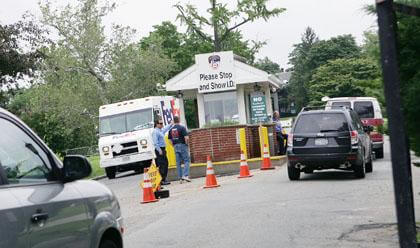By Nathan Duke
The Fire Department resumed its security detail at Fort Totten this week following the department’s decision in March to pull its guards from the Bayside park’s gates amid budget cuts.
On Monday, the FDNY posted light duty personnel at the fort’s entrance after weeks of negotiations led to the money being restored to the department’s budget. The gate will be guarded around the clock, an FDNY spokesman said.
Bayside leaders, who had been concerned about safety and vandalism at the fort after the department removed its security detail, said they were pleased the park will once again be guarded.
“I hope this makes people feel safer,” said Warren Schreiber, president of the Bay Terrace Community Alliance. “There are old buildings in the park that are abandoned and boarded up. So we had concerns about vandalism and arson.”
The FDNY had announced it would hand over security to Flushing’s 109th Precinct March 1 when the department’s contract expired amid budget constraints. For the past two years, the fort had been guarded by FDNY members who occupied a booth at its entrance gate. The fort is home to the Bayside Historical Society, an NYPD K-9 unit and an emergency services unit.
State Sen. Frank Padavan (R-Bellerose) said the detail at the fort’s gate will be restored following weeks of negotiations between the city and the FDNY. On July 1, security guards will also be added at the site.
“This security presence is vital to daily operations of the fort and will help deter any potential instances of crime in or around the area,” Padavan said.
The U.S. Army Corps of Engineers is also in the process of putting together its feasibility study to determine how to remove contaminated soil at the fort, said Helen Edge, the project manager for the remediation project.
The Army first discovered soil contamination at the fort in the 1980s and has long planned to clean up the site. It is believed the polluted ground was caused by the production and use of mercury-vapor searchlights at the fort from the late 1870s through the 1960s.
Edge said the soil at the fort is contaminated with mercury, lead and semi-volatile organic compounds. But the site does not pose health risks to its inhabitants, she said.
“Unless somebody disturbs it, the contamination isn’t going anywhere,” she said.
The US Army Corps of Engineers will release the results of its feasibility study in September, which will be followed by its proposed plan to clean up 9.6 acres at the fort. In December, public comment on the project will begin and then the state will have to approve the finalized plan.
The cleanup involves remediating 35 hot spots of contamination near the former Coast Guard property at the fort, Edge said.
Reach reporter Nathan Duke by e-mail at nduke@cnglocal.com or by phone at 718-229-0300, Ext. 156.

































